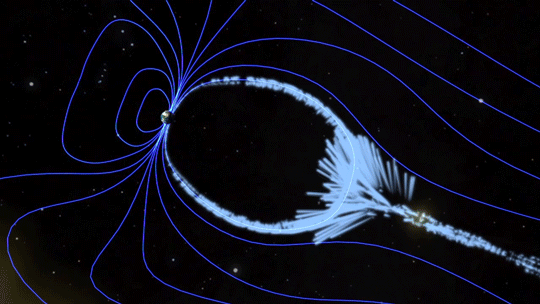
Light-speed travel is a staple of science fiction in space. No "Star Wars" movie seems complete until the Millennium Falcon (or a rival ship) uses its hyperdrive. And many "Star Trek" fans enjoy talking about the relative star-system-jumping speeds of the USS Enterprise, against the speeds of other Federation ships.
But in real life, physics gets in the way. Einstein's theory of special relativity essentially puts a speed limit on cosmic travel; as far as we can tell, nothing goes faster than the speed of light. Worse, any object that has mass tends to get more and more massive — dragging down the object's velocity — as it approaches light speed. So as far as we know, only small particles can get anywhere near the speed of light.
One hundred years ago, on May 29, 1919, scientists performed measurements of a solar eclipse that confirmed Einstein's work. To celebrate, NASA offered three ways that particles can accelerate to amazing speed in a new statement.
Related: Why Don't We Have a 'Star Wars' Hyperdrive Yet?
Electromagnetic fields
The sun is a wacky environment to study physics, because it is so extreme compared to Earth. It's also a real-life laboratory showing how nuclear reactions happen. It also is an example of an environment with electromagnetic fields — which, as NASA points out, is the same force that stops magnets from falling off your fridge.
Magnetic fields and electric fields work together to accelerate particles with an electric charge. This charge allows electromagnetic fields to push particles along — sometimes at speeds approaching the speed of light.
We can even simulate this process on Earth. Huge particle accelerators (like at the Department of Energy's Fermi National Accelerator Laboratory, or at the European Organization for Nuclear Research's Large Hadron Collider) create pulsed electromagnetic fields. These fields accelerate charged particles close to the speed of light. Next, scientists often crash these particles together to see what particles and energy are released.
In fractions of a second after these collisions, we can quickly observe elementary particles that were around in the first few seconds after the universe was formed. (That event, called the Big Bang, happened about 13.8 billion years ago.)
Magnetic explosions
The sun is also host to phenomena called solar flares. Dancing above the sun's surface is a tangle of magnetic fields. At times, these fields intersect and snap, sending plumes of solar material off the surface — and, sometimes, charged particles along with it.
"When the tension between the crossed lines becomes too great, the lines explosively snap and realign in a process known as magnetic reconnection," NASA officials said in the statement. "The rapid change in a region's magnetic field creates electric fields, which causes all the attendant charged particles to be flung away at high speeds."
Particles streaming off the sun may accelerate close to the speed of light, thrown from the sun thanks to magnetic reconnection. One example of such objects is the solar wind, the constant stream of charged particles the sun emits into the solar system. (There may be other factors speeding these particles as well, such as wave-particle interactions — which is explained in the next section of this article.)
Magnetic reconnection also likely happens at large planets, such as Jupiter and Saturn. Closer to home, NASA studies magnetic reconnection near Earth using the Magnetospheric Multiscale mission, which measures our planet's magnetic field using four spacecraft. The results may be useful to better understand how particles accelerate all over the universe, NASA officials said.
Wave-particle interactions
Particles can also careen at high speeds when electromagnetic waves collide; that phenomenon is more technically called wave-particle interactions.
"When electromagnetic waves collide, their fields can become compressed. Charged particles bouncing back and forth between the waves can gain energy similar to a ball bouncing between two merging walls," NASA officials said.
These interactions take place all over the universe. Near Earth, NASA missions such as the Van Allen probes are watching wave-particle interactions to better predict particle movements — and protect electronics on satellites. That's because high-speed particles can damage these delicate spacecraft parts.
Supernovas, or star explosions, may also play a role in more far-away interactions. Researchers have theorized that after a star explodes, it creates a blast wave — a shell of hot, dense compressed gas — that zooms away from the stellar core at high speed. These bubbles are full of charged particles and magnetic fields, creating a likely environment for wave-particle interactions. This process may eject high-energy cosmic rays — which consist of particles — at velocities close to the speed of light.
Follow Elizabeth Howell on Twitter @howellspace. Follow us on Twitter @Spacedotcom and on Facebook.
https://www.space.com/fundamental-particles-travel-speed-of-light.html
2019-05-31 10:41:00Z
52780306863370
Bagikan Berita Ini















0 Response to "3 Ways Fundamental Particles Travel at (Nearly) the Speed of Light - Space.com"
Post a Comment